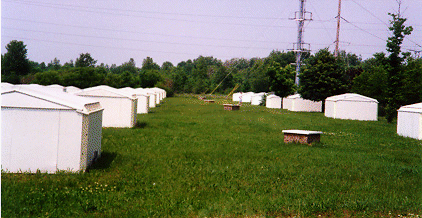

Each station of detectors is enclosed by a 2.4 x 2.4 m2 hut.
Inside are eight planes of proportional wire chambers (PWCs)
and a 2" (50.8 mm) thick steel absorber plate.
The chambers have been surveyed to <0.05 deg.
The temperature of the huts is heated to 17 deg C in the winter.
Dehumidifiers control the humidity to <55%.
The planes are arranged in xy pairs
that are separated vertically by 200 mm.
The top three pairs measure the xz and yz-angle of a track.
The pair below the 50 mm steel plate identifies muons with
96% accuracy for each track.
George Charpak received the Nobel prize in 1992
for inventing the PWC detector used in physics and medicine;
GRAND has pioneered its
adaptation for cosmic rays.
Construction utilized mass production techniques to
economically manufacture precision detectors.
The planes are 1.29 m2 in area and have 80 cells
per plane with eight planes in each detector station.


Back to GRAND Homepage